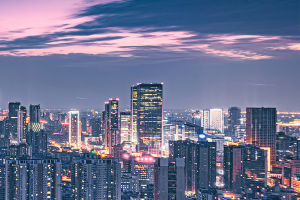When night falls and the city lights up, the entire cityscape becomes a colorful and vibrant spectacle.
This moment presents a beautiful nocturnal scene that many would love to capture with their cameras. There are numerous picturesque views to capture in the city at night, and this article primarily focuses on how to achieve stunning cityscape photographs.
For beginners, taking photos at night is more challenging than during the day, requiring attention to several factors:
1. Equipment Preparation:
When capturing nightscapes, it's best to use a camera that supports Manual Mode (M mode). Typically, wide-angle lenses (around 18mm) are used for night photography as they capture expansive scenes and grandeur. Using different focal lengths at the same location will alter the field of view—shorter focal lengths provide broader perspectives while longer focal lengths narrow the view.
The main difference between day and night photography is the lower light conditions at night. To maintain image brightness, longer shutter speeds are often necessary, necessitating the use of a tripod to avoid blurry photos. Despite the inconvenience, carrying a tripod is essential for capturing beautiful nightscapes effectively.
2. Timing:
The best time to capture night scenes is during the transition from dusk to nightfall, when it's not entirely dark yet.
During the transition from dusk to nightfall, the sky retains some blue hues, providing a more layered effect to the photographs. Arriving at the shooting location before complete darkness allows for capturing both nightscapes and the lingering glow of sunset, offering versatile photographic opportunities.
3. Location:
Optimal locations include elevated points such as rooftops, high-rise cafés, or observation decks, allowing for a bird's-eye view that accentuates the spatial relationships between buildings and their surroundings, creating a grandiose atmosphere.
When shooting, using a smaller aperture helps to sharply define distant architectural details.
Utilizing a wide-angle lens from an elevated perspective captures more of the cityscape, effortlessly conveying the spatial depth and extension of the buildings. Alternatively, exploring different angles such as low angles, eye-level shots, or even aerial perspectives (with safety precautions) can provide diverse compositions.
4. Practical Techniques:
a. Reflections:
Incorporating reflections from water bodies into architectural or cityscape compositions is a simple yet effective method to enhance visual impact and create a sense of ambiguity and allure in the image. Integrating water reflections as part of the composition juxtaposes reality with its mirrored counterpart, adding emotional depth and visual intrigue. With a telephoto lens, one can focus solely on the water surface, abstracting the imagery through ripples and creating a unique ambiance.
b. Iconic Landmarks:
While exploring urban streets, pay attention to distinctive landmarks or symbols representing the local identity, such as signage or street indicators. Integrating these elements into the surrounding environment provides context and serves as concise visual cues, aiding in storytelling and memory recall.
City nightscapes offer abundant photographic opportunities, and adhering to conventional norms should not limit creativity. By observing keenly, seizing the moment, leveraging equipment and techniques effectively, and nurturing a passion for life, anyone can capture breathtaking cityscape masterpieces.


